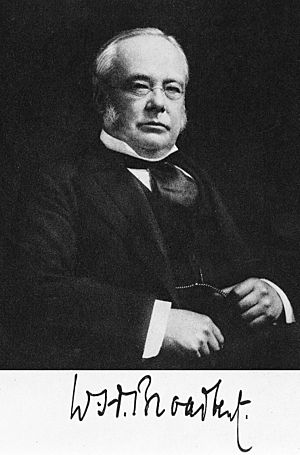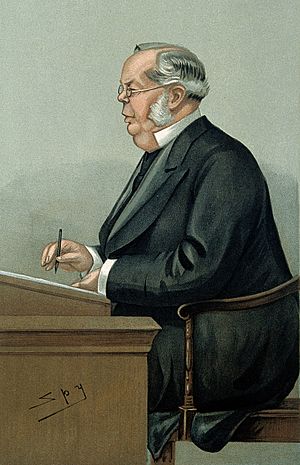William Broadbent facts for kids
Sir William Henry Broadbent (born January 23, 1835 – died July 10, 1907) was a famous English doctor. He was an expert in two important medical fields: cardiology (the study of the heart) and neurology (the study of the brain and nervous system). He also researched diseases like tuberculosis and cancer. Sir William was a special doctor to Queen Victoria and later to King Edward VII and the Prince of Wales.
Contents
Early Life and School
William Broadbent was born in a place called Longwood Edge, which is now part of Huddersfield in West Yorkshire. He was the oldest of seven children. His father, John Broadbent, made wool and was a well-known member of the Wesleyan church.
William went to school at Huddersfield College. After that, he decided he wanted to become a doctor. He first worked as an apprentice to a doctor in Manchester. Then, he studied medicine at Owens College and the Royal School of Medicine, both in Manchester. In 1857, he traveled to Paris to continue his studies. He returned in 1858 and passed his medical exam in Manchester.
A Doctor's Career
In 1859, Sir William Broadbent started working at St Mary's Hospital, London. He worked there for most of his career, until 1896. The next year, he also became a doctor at the London Fever Hospital. By 1865, he was in charge of patients at St. Mary's. He became a full physician there in 1871.
It was at St. Mary's Hospital that Broadbent became known as a brilliant doctor and a great teacher. He was especially good at understanding diseases and teaching others about them. His main areas of knowledge were heart and brain conditions. He also worked with cancer and typhoid fever.
A very important time for Broadbent was between November 1891 and October 1892. During this period, he helped the Royal Family. In late 1891, he helped save the life of Prince George (who later became King George V) when the prince had typhoid fever.
In January 1892, the Royal Family asked Broadbent to help save Albert Victor, Duke of Clarence and Avondale. This prince was the older son of the Prince and Princess of Wales. He was next in line to become king. The prince had a very strong type of flu. Broadbent tried his best to save him, but the prince sadly died on January 14, 1892. Even so, the Prince of Wales sent Broadbent a letter thanking him for his efforts.
Broadbent was a special doctor to Queen Victoria. He was also a regular doctor to King Edward VII and the Prince of Wales. In 1904, he was listed as an honorary medical staff member at King Edward VII's Hospital for Officers.
Awards and Honours
Sir William Broadbent received special honorary doctorates from several universities. These included the University of Edinburgh, St. Andrews, Leeds, McGill in Canada, and the University of Toronto, also in Canada.
In 1893, he was given the title of baronet. This is a special honour from the King or Queen. In March 1901, he was also made a Knight Commander of the Royal Victorian Order.
Family Life
Sir William Broadbent married Eliza Harpin in 1863. They had six children: three sons and three daughters.
- Mary Ethel (1864 – 1954)
- John Francis Harpin (1865 – 1946)
- William Herbert (1867 – 1867)
- Walter (1868 – 1951)
- Gertrude (1870 – 1905)
- Eliza Madeleine (1872 – 1949)
Two of his sons, John and Walter, also became doctors.
Sir William Broadbent passed away at his home in London in 1907. He had been ill for about eight months after getting pneumonia. His oldest son inherited his baronet title.
Medical Terms Named After Him
Sometimes, medical conditions or signs are named after the doctors who first described them. Here are some named after Sir William Broadbent or his son:
- Broadbent apoplexy: This is a type of stroke. It happens when there is bleeding in the brain's fluid-filled spaces.
- Broadbent sign: This is a physical sign that doctors look for. It involves a slight pulling in of the spaces between the ribs on the left side of the back. It can be a sign of a problem with the sac around the heart. (This sign was actually first described by his son, Walter Broadbent, in 1895).
- Broadbent law: This is a medical rule about how brain damage affects muscles. It says that damage to the upper part of the brain's motor control area causes less weakness in muscles that usually work together on both sides of the body. It causes more weakness in muscles that often work on their own.
Selected Books and Writings
Sir William Broadbent wrote several important medical books and articles:
- Cancer: A New Method of Treatment (1866)
- The Pulse (1890)
- Heart Disease, With Special Reference to Prognosis and Treatment (1897) – He wrote this with his son, John Francis Harpin Broadbent.



